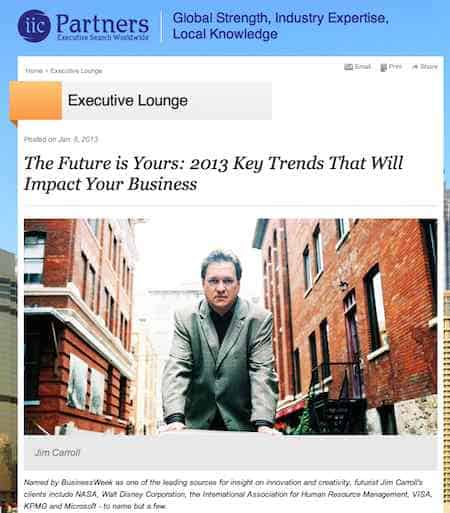IIC Partners is one of the world’s Top 10 executive search organizations, with 55 offices in 39 countries. They operate in the Industrial, Financial Services, Consumer & Retail, Energy, Life Sciences, Technology, Board Search, Higher Education, Infrastructure and Human Resources sectors.
 Pretty well everyone that I’ve been busy focusing on trends and innovation for close to 20 years.
Pretty well everyone that I’ve been busy focusing on trends and innovation for close to 20 years.
So I was thrilled when they interviewed me for their Executive Lounge, which is made available to an extensive number of senior executives worldwide. The result was this article, which is a good summary of some of the big trends I’m thinking about for 2013.
“The Future is Yours: 2013 Key Trends That Will Impact Your Business!”
by Polly Stewart, Named by BusinessWeek as one of the leading sources for insight on innovation and creativity, futurist Jim Carroll’s clients include NASA, Walt Disney Corporation, the International Association for Human Resource Management, VISA, KPMG and Microsoft – to name but a few.
Jim shares his views on the six key trends for 2013 and beyond, executives need to know about, exclusively with IIC Partners Executive Lounge members.
1. The Moore’s Law Effect
“With computer processing capability doubling every 18 months to two years, technology will impact on every single sector. Business leaders in every single sector are going to find that they are being exposed to this same accelerating rate of change.
“Take healthcare, which is moving into a world of DNA-based diagnosis and treatment. Strands of DNA can be used to predict and treat conditions. The cost it took to develop the human genomic sequencing machines was $US3 billion – now it costs a thousand bucks. Genomic medicine is driving the health care revolution because of the exponential increase in processing speed of these machines – and that’s just one example, in one sector.”
2. Loss of Control
“Most industries are losing control of the pace of innovation. Take financial services and insurance for example, Insurethebox [which allows people to control their car insurance insurance premiums via a GPS that reports back safe driving metrics], and digital wallets appearing on cell phones. There is Square – a little iphone credit card device and all I need to do to take credit card payments is plug it into my iphone and hey presto I am in business and can take payments. Previously setting up merchant accounts to take credit card payments was like pulling hens’ teeth. But it wasn’t the credit card companies that invented this little device – they are way behind.
“What’s happened in these cases is that the insurer or the bank or the credit card company is no longer controlling the speed of innovation, so when it comes to motor insurance or mobile payments, the insurance companies and banks have lost control of the spend. Tech companies innovate a heck of a lot faster than any other company in any other sector and so technology is setting the agenda.”
3. Product and Service Reinvention
“Traditional products are being reinvented, again it’s down to technology. Think about the thermostat in your home. It’s been the same type of device for 50 years. Now there is Nest, a learning thermostat designed by one of the key designers of the ipad. It’s a fast learning device that has an intelligent iphone app and it sells for $US250. Tech companies environments are not encumbered by history. A lot are small and are start-ups are very collaborate and actively seek knowledge and insight.
“Some organisations have a culture that stifles innovation. Innovation is not an age thing, it’s a culture thing. All organizations need to be aware they may need to reinvent business models very quickly.”
4. Revolution in retail
“Traditional retail is fascinating right now. It’s about interaction and interactive experience. The Apple checkout process has even done away with cash registers and they have digital display screens all over the place. Watch this space – traditional retailers are learning how to compete successfully against internet retailers.”
5. Career Reinvention
The economy is coming back to strength but in the industrial sector, what is happening is brute force labour is being replaced by robotics. Where can you find people with the skills to control those robots? I have client who told me it’s almost to the point where the people they are hiring they almost have to be able to do trigonometry in their heads. This is happening in a lot of jobs and it comes back to technology. From retail to banks and manufacturing to farming – even farmers need knowledge now about bio-genetics.
“How do people train their minds to think beyond their routine and job description? Organizations are not charging their people to think about future trends, to think about future innovation. Everyone needs to be involved: Where are the trends going? Where the competitors will come from? How many people have the word ‘innovation’ in their job description?”
6. Hyper connectivity
“Looking beyond 2013 to 2014, hyper connectivity is key. Everything in our lives is becoming plugged in to everything else. The status and location and IP address of every devise we use will create threats and big opportunities.
“I can see the day when I get up in the morning, go and weigh myself and the bathroom scales send a message to my refrigerator saying, ‘Don’t let Jim in – he’s broken his end of the deal!'”
Find out more about Jim’s predicitions at
By Polly Stewart




GET IN TOUCH
Jim's Facebook page
You'll find Jim's latest videos on Youtube
Mastodon. What's on Jim's mind? Check his feed!
LinkedIn - reach out to Jim for a professional connection!
Flickr! Get inspired! A massive archive of all of Jim's daily inspirational quotes!
Instagram - the home for Jim's motivational mind!